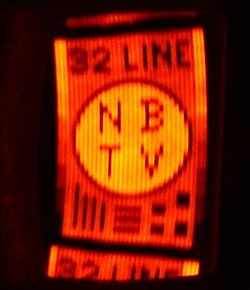Engineering:Narrow-bandwidth television
Narrow-bandwidth television (NBTV) is a type of television designed to fit into a channel narrower than the standard bandwidth used for official television standards.
The three predominant worldwide broadcast television standards use either 6 MHz wide channels (as in the Americas and Japan, as ATSC and ISDB-T both use those standards) or 8 MHz (as in most of Europe with DVB-T). Narrow-bandwidth television refers to any method that reduces the bandwidth below that threshold. (These techniques are frequently used in traditional television to allow for multiple digital subchannels on the same bandwidth, but this is not true narrow-bandwidth as the standards do not allow for it, and the extra bandwidth in these cases is usually transferred to another channel.)
Design
There are three ways to reduce the bandwidth of a video signal: reduce the scan rate, reduce the image size, and/or (with digital television) use heavier compression. When the scan rate is reduced, this is referred to as slow-scan TV or, in the most extreme cases when the scan rate is too slow to simulate motion, freeze frame television. With reduced image sizes, this is referred to as low-definition television. In the most extreme cases, the number of lines in an image may be reduced to just a few dozen, and bandwidth reduced to a few tens of kilohertz, within the bandwidth of an amateur radio voice channel. Most narrow-bandwidth TV nowadays uses computers and other electronic systems.
Mechanical TV standards
The earliest mechanical television systems often used narrow channels for sending moving images. Often, the images were only a few dozen lines in size.
| Name | Details |
|---|---|
| Nipkow 1884 | 24 lines. Patent granted but Nipkow did not build a system. |
| WGY, 2XAF, 2XAD | 24 lines, 21 frame/s, progressive scan |
| United Kingdom, 1926 (Baird) | 30 lines, 5 frame/s, black-and-white experimental transmissions |
| United Kingdom, 1928 (Baird) | 30 lines, 5 frame/s, first experimental colour TV transmissions[1] |
| W3XK, Washington, D.C, 1928 | 48 lines. Oldest television station in the United States.[2] |
| 2XAL, WRNY "Radio News", New York, 1928 | 48 lines, 7.5 frame/s, progressive scan. Second to broadcast television pictures to the general public, after W3XK in Washington, D.C.,[3][4][5][6][7][8] |
| Baird, United Kingdom, 1928–32 | 30 lines, 12.5 frame/s, 3:7 vertical aspect ratio, vertical progressive scan, ~70x30 pixels per frame, sound, live TV from studio, first outdoor remote broadcasts of the Derby[9] |
| W9XAA/WCFL, W9XAO/WIBO, W9XAP/WMAQ (Western Television / Sanabria), Chicago, 1928–33 | 45 lines, 15 frame/s, 1:1 aspect ratio, triple interlace scan. Live TV from studio. (Above transmissions: Picture station / sound station)[10] |
| W9XK/WSUI, Iowa City, Iowa (Used Western Television/Sanabria system), 1933–39 | 45 lines, 15 frame/s, 1:1 aspect ratio, triple interlace scan. Includes sound on WSUI. Educational TV pioneer. Live TV from studio.[10] |
| Germany, France, 1930 | 30 lines, 12.5 frame/s, 3:4 aspect ratio, horizontal progressive scan |
| New York City, Schenectady, Boston, 1930–31 | 48 lines, 15 frame/s, 6:5 aspect ratio, horizontal progressive scan |
| W6XAO Los Angeles, 1931 | 80 lines, 20 frame/s, progressive scan |
| W6XAH Bakersfield, 1931 | 96 lines, 20 frame/s, progressive scan |
| New York, Schenectady, Boston, 1932 | 60 lines, 20 frame/s, 6:5 aspect ratio, horizontal progressive scan |
| Berlin 1932 | 30 lines, 12.5 frame/s, 4:3 horizontal aspect ratio, ~40x30 pixels per frame, test movies and live images |
| Königs Wusterhausen 1932 | 39 lines, 12.5 frame/s, 4:3 horizontal aspect ratio, ~31x30 pixels per frame, movies |
| Doberitz 1932 | 48 lines, 25 frame/s, 4:3 horizontal aspect ratio, ~64x48 pixels per frame, sound, talking movies |
| Berlin R.P.Z. 1932 | 60 lines, 25 frame/s, 4:3 horizontal aspect ratio, ~83x60 pixels per frame, test movies and live images |
| Italy 1932 | 60 lines, 20 frame/s, 4:3 horizontal aspect ratio, ~45x60 pixels per frame, test movies and live images |
| France 1932 | 60 lines, 12.5 frame/s, 3:7 vertical aspect ratio, vertical scanning ~35x60 pixels per frame, sound, live images[11] |
| Switzerland 1932 | 30 lines, 16.6 frame/s, 4:3 horizontal aspect ratio, ~40x30 pixels per frame, test movies and live images |
| USSR 1932 | 30 lines, 12 frame/s |
| Belgium 1932 | 30 lines, 12.5 & 16.6 frame/s, 4:3 horizontal aspect ratio, ~40x30 pixels per frame, sound, talking movies |
See also
- History of television
- List of experimental television stations
- Moving image formats
- Prewar television stations
- Television systems before 1940
- PXL2000
References
- ↑ John Logie Baird, Television Apparatus and the Like, U.S. patent, filed in U.K. in 1928.
- ↑ "The short and the long of milestones in television". Press-Enterprise. July 27, 2006. http://www.pe.com/lifestyles/stories/PE_Fea_Ent_D_tv.smallside.10b8ee9.html. Retrieved September 13, 2010.
- ↑ "Vol. 12 No. 23 (28 September 1928)". https://nla.gov.au/nla.obj-738744652.
- ↑ "Radio News, October 1928". 10 September 1928. https://commons.wikimedia.org/wiki/File:Radio_News_Oct_1928_pg343.png.
- ↑ Fournier, Lucien (March 1924). "Television by the Belin System". Practical Electrics 3 (5): 244–246.
- ↑ "Television For All Planned This Fall". The New York Times: p. 18. April 23, 1928.
- ↑ "Giant Photoelectric Cell for WRNY'S Television Transmitter". Radio News 10 (3): 221. September 1928. http://commons.wikimedia.org/wiki/Image:Radio_News_Sep_1928_pg221.png.
- ↑ "Today on the radio". The New York Times: p. 29. August 21, 1929.
- ↑ BAIRD, J.L. BAIRD (1933). "BBC Annual Report". https://www.bairdtelevision.com/television-in-1932-bbc-annual-report-1933.html.
- ↑ 10.0 10.1 "Early Chicago Television, Mechanical Tv, Ua Sanabria". Hawestv.com. http://www.hawestv.com/mtv_chicago/mtv_cgo.htm. Retrieved 2010-03-02.
- ↑ Herbert, Stephen (2004). A History of Early Television. ISBN 9780415326674. https://books.google.com/books?id=BlZF20ggFhsC&dq=german+180+lines+tv&pg=PA15.
External links
 |


